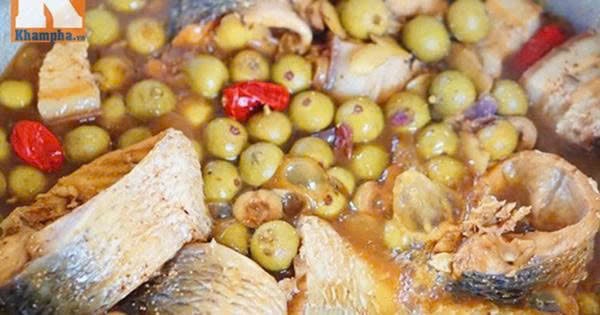In the vast repertoire of Vietnamese cuisine, fish stew holds a special place with its robust flavor, ease of eating, and versatility in family meals. When combined with the humble jujube – a fruit rich in fiber and nutrients – the stew becomes not only more delicious but also exceptionally nutritious and appealing. Here’s a guide to stewing fish with salted jujubes, a wonderful addition to your family’s menu.
Jujube – A Nutritious Fruit:
Jujubes are a familiar fruit in rural Vietnam, usually growing in small clusters with a mild astringent taste when fresh and a sweet, nutty flavor when properly prepared. According to traditional medicine, jujubes aid digestion, relieve constipation, detoxify the body, and reduce blood fat. Modern science also recognizes the fruit’s high fiber content and abundance of vitamins A, C, and B1, as well as minerals like calcium, potassium, and magnesium, all beneficial for cardiovascular health and digestion.
When salted jujubes are used in stewing fish, their mild sourness and crunchy texture permeate the fish meat, creating a harmonious, aromatic, and exceptionally tasty dish.

Ingredients and Preparation:
To create an authentic-tasting fish and jujube stew, gather these simple ingredients:
Main Ingredients:
- Fish (you can use freshwater fish like carp or rohu, or sea fish like mackerel or gobies, depending on your family’s preference)
- Pork belly or ribs (for a richer, more flavorful stew)
- Salted jujubes (lightly salted for about 2 days)
Quick Jujube Salting Method:
Mix 1 bowl of vinegar, 1 bowl of sugar, 1 bowl of water, and 1 teaspoon of salt. Add crushed ginger, lemongrass, and horn pepper to taste. Bring the mixture to a boil, let it cool, and then soak the halved jujubes for 2 days before use.
Stewing Spices:
- Chopped onions and garlic
- Fish sauce, sugar, and coloring (caramel or soy sauce)
- Cooking oil (for a glossy appearance)
- Chili paste or fresh chilies (for a spicy kick and attractive color)
Cooking Process:
Step 1: Prepare the Ingredients
Clean and dry the fish. If using large fish, cut them into chunks.
Cut the pork belly into bite-sized pieces.
Rinse the salted jujubes briefly to reduce saltiness, leaving them whole or halving them.
Sauté the onions and garlic, then add the spice mixture to the pan: sugar, fish sauce, coloring, cooking oil, and chili paste. Simmer until the mixture thickens, adjusting the seasoning to taste.
Step 2: Assemble the Stew
Line the bottom of the stew pot with a layer of pork.
Dip each piece of fish into the sauce and arrange them on top of the pork.
Spread the jujubes over the fish, ensuring even coverage to infuse the fish with flavor during stewing.
Pour the remaining sauce over the ingredients and marinate for about 2 hours.
Step 3: Stew the Fish
Place the pot on medium heat and simmer for approximately 45 minutes until the fish is cooked and the pork is tender.
Turn off the heat, let it cool completely, and then reheat for a second stewing. Continue cooking until most of the liquid has evaporated and the fish is firm.
Double stewing is especially suitable for sea fish, resulting in firmer meat.
A Delicious and Nutritious Dish:

The finished dish presents an alluring golden-brown color, exuding the enticing aroma of fish, meat, spices, and jujubes. The fish is tender yet firm, infused with a perfect balance of salty, sweet, and spicy flavors. The salted jujubes become soft and buttery, absorbing the rich flavors of the stew, making it exceptionally tasty with rice.
If you’ve made a large batch, you can portion it into smaller containers and freeze them. When needed, simply reheat to enjoy the original flavor.
Health Benefits of Fish and Jujube Stew:
This dish not only delights the taste buds but also offers numerous health benefits due to the combination of protein from the fish and the fiber and vitamins from the jujubes. It aids digestion, lowers cholesterol, promotes heart health, and helps maintain a healthy weight.
- For added variety, include quail eggs or tofu in the stew.
- Choose young jujubes with fewer seeds for a less astringent, sweeter taste.
- If you prefer less spice, reduce the amount of chili or use sweet chili paste instead.
The fish and jujube stew is an ideal choice for those seeking a rustic yet nutritious meal. With easily accessible ingredients and a simple preparation method, a touch of creativity will bring a delightful traditional dish to your family table, free from monotony.
The Ultimate Guide to Tender Meat: The Secret to Using “Sky-Suspended” Water for the Perfect Dish
For those who are accustomed to the traditional way of braising meat, it’s time to elevate your culinary game with a special twist – braising meat in coconut water, a liquid likened to “heavenly nectar”. With its naturally sweet and refreshing taste, coconut water adds a unique dimension to your dish, eliminating the need for elaborate spices.
“The Ultimate Guide to Crispy, Tangy Fried Squid: A Mouthwatering Delight”
Squid fried in fish sauce is a familiar dish, but not everyone knows the secret to achieving that crispy, savory restaurant flavor. This article will reveal the step-by-step guide to selecting the finest ingredients and creating a mouthwatering sauce, empowering you to master this delicacy in your own kitchen.
Young People from Thanh – Nghe – Tinh Introduce Their Hometown Delights!
“For the ultimate culinary adventure, embark on a journey through the flavors of Thanh Hoa, Nghe An, and Ha Tinh. These three provinces boast a plethora of unique delicacies that are sure to tantalize your taste buds. From the pungent yet addictive mam tom (fermented shrimp paste) and nuoc mam (fish sauce) to the savory bahn ram (grilled pork patties) and the healthy tra ca gai leo (bitter melon tea), there’s something for every palate. Join us on the latest episode of ‘Tinh Hoa Viet Du Ky’ as we explore these regions and uncover their culinary treasures, airing on December 15th.”






































